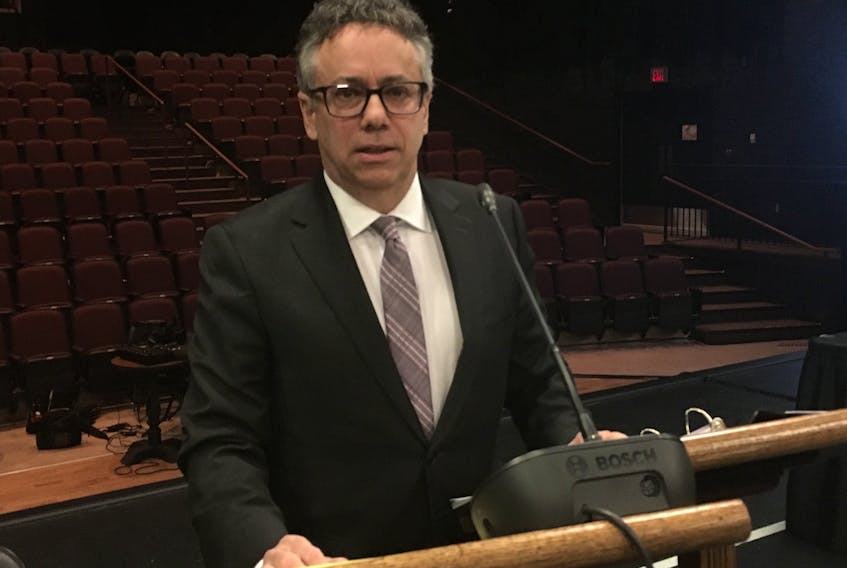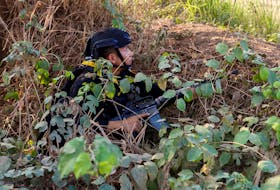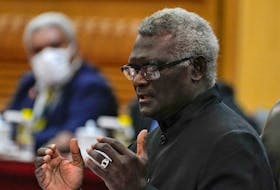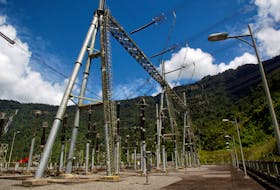HAPPY VALLEY-GOOSE BAY, N.L. — Astaldi Canada is pushing back against any suggestion it should be blamed for the delays and blown budget of the Muskrat Falls project.
Lawyer Paul Burgess, representing the company, questioned forensic auditor Scott Shaffer on Thursday during the ongoing hearings of the Muskrat Falls Inquiry in Happy Valley-Goose Bay.
Under questioning from Burgess, Shaffer explained his work looks at costs and productivity, and positions of parties involved, but is not assigning blame.
Shaffer noted Astaldi Canada signed agreements for the contract package for the intake, powerhouse, spillway and transition dams in November 2013.
“Would you agree with me that the fact that Nalcor insisted Astaldi start in November of 2013, being the winter months and the climate in Labrador, rather than July 2013, that would be a significant factor in the slow start? Would you agree with that?” Burgess asked Shaffer.
“Well, based on the winter season and based on what (Astaldi project manager) Don Delarosbil told us, I would think so,” Shaffer replied.
The auditor confirmed the contract award had been delayed due to a delayed release of project work from environmental assessment and a delay in financial close – events unrelated to Astaldi Canada.

Delarosbil is quoted in Shaffer’s report to the inquiry: “If you start in November instead of June you’re not just losing four months, you’re probably losing 10 months. You almost lost a year of construction,” he says, referring to the initial delay.
Previous testimony, as well as Shaffer’s, has noted the slow start to Astaldi’s work at the dam site, with productivity levels well below what was suggested in SNC-Lavalin’s estimate for the project and in the Astaldi bid. Shaffer’s report noted the company recovered later, improving its concrete pour rate significantly through 2015.
Shaffer makes note of the integrated cover system (“ICS”), sometimes referred to by the public as “the dome,” that formed part of Astaldi’s proposed project plan. The ICS was proposed as a shelter to workers from the elements. It was partially built and then torn down, while construction forged ahead at the dam site.
As mentioned by Nalcor Energy lawyer Dan Simmons, Astaldi’s original bid for the work was not the only one to propose a covering like the ICS. Astaldi sub-contracted ICS construction to Proco Inc. Proco has claimed Astaldi made schedule revisions and decisions slowing its work. The subcontractor, as per Shaffer’s report, also said Astaldi failed to perform its obligations under the subcontract. On the other side, it’s reported Astaldi cancelled the contract because Proco failed to deliver on time, had excessive labour hours and provided poor management.
Shaffer provided the comments from different parties involved, but confirmed to Burgess he is not an engineer and could not to speak to the approach and conclusions on the covering, beyond the numbers and comments provided. The cost of the removal of the ICS is noted as one part of a collection of change orders amounting to roughly $18 million in additional costs.
On the subject of productivity and pouring of concrete, Burgess asked about monthly figures and charts used by Shaffer.
Shaffer said the report should say monthly pour targets were met 10 times out of 50 (not nine times out of 57 as stated).
Shaffer also agreed a line chart in the report doesn’t offer details of events such as — in an example offered by Burgess — a hold on concrete pouring from December 2015 to March 2016. But Shaffer said the point is the numbers in the bid did not match the numbers in reality.
As noted in the auditor’s report, in March 2016 Westney Consulting reported to Nalcor that Astaldi had experienced “significant crew ‘stand around’ time,” limited management presence in work areas, and disorganized laydown areas, with debris and clutter in other areas. The same report noted marked improvements over time, including a motivated workforce, increased presence of management, and improved cleanliness and organization at the site.
Burgess noted Astaldi’s bid on its part of the project was not an outlier, but close to that of a partnership including Italian-based Salini.
He also made the point Astaldi was not responsible for the entire Muskrat Falls hydroelectric project (even if, as Shaffer noted, it accounts for roughly 30 per cent of the overruns).
Canadian content
Meanwhile, Astaldi Canada has been receiving negative commentary since before it began on the Muskrat Falls project. In September 2013, prior to the awarding of one of the main Muskrat Falls construction packages to Astaldi Canada, The Telegram spoke with former minister of Natural Resources Shawn Skinner, who had already appeared on VOCM radio at that time, warning the contract package should go to a Canadian company.
There was more risk associated with an outside company, warned Skinner, then working with Aecon — in a partnership that was a competitor to Astaldi Canada for the work at Muskrat Falls.
Also back in September 2013, as per the more recent auditor’s report to the Muskrat Falls Inquiry, Astaldi Canada was awarded the contract package and issued a “limited notice to proceed.” The contract award date is typically reported as November 2013, because that’s when commercial contracts were signed.
“Ultimately for us, at this point in time, we’re interested in best value for the people of the province. So we need a contractor who can do the work safely, can meet our specifications and the other Canadian specifications that are associated with the work and, of course, one that gives us best commercial value,” Nalcor Energy’s Muskrat Falls project lead Gilbert Bennett said at the time.
“When (foreign contractors) come in, because they can’t properly evaluate their risks, they’re much cheaper than the other guys – like 25, 30 per cent. These are not the kinds of margins we have in our projects, but that’s how much cheaper they are." — John Beck
And in late 2013, still before the contract was signed with Astaldi, Aecon Group chairman and CEO John Beck made public statements along the same line as Skinner’s. He issued a warning on overruns, saying major contracts on Canadian megaprojects should go to Canadian companies or, at the very least, companies with a Canadian joint-venture partner, who understand the jurisdictional demands.
“When (foreign contractors) come in, because they can’t properly evaluate their risks, they’re much cheaper than the other guys – like 25, 30 per cent. These are not the kinds of margins we have in our projects, but that’s how much cheaper they are,” Beck told The Telegram, explaining the lower bids are difficult to reject. He said it had become a problem in projects across Canada.
The Telegram also heard from others, who suggested Beck’s comments were merely self-serving.
More recently, as reported, Nalcor Energy lawyer Dan Simmons pointed out cost increases specific to Astaldi Canada at Muskrat Falls have brought the cost of the contract package to a position still comparable with what other original bidders were offering, including the Aecon partnership, and there were no guarantees another contractor wouldn’t have overrun their bid.
Astaldi Canada and Nalcor Energy are still battling in the courts over the project.
Twitter: @TeleFitz
RELATED STORIES:








